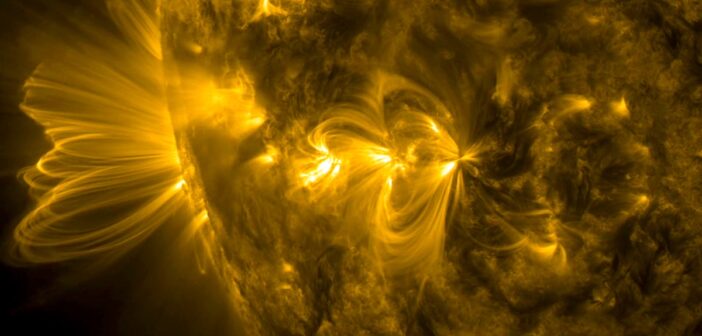Many models of the Sun’s upper atmosphere, or corona, use magnetohydrodynamics, in which collections of particles are assumed to behave like an electrically conducting fluid. A recent research article explores how sensitive magnetohydrodynamics models are to the conditions they start with.
A Powerful Modeling Tool

Two coronal mass ejections launched from the Sun in November 2000, as seen by the Solar and Heliospheric Observatory. [ESA/NASA/SOHO]
With so many ways to implement these models, it’s worth taking the time to consider how choices of model parameters affect the outcome. In other words, how much does what you get out depend on what you put in?
Testing Model Memory
To begin to address this question, Graham Barnes (NorthWest Research Associates) and collaborators studied the impact of initial conditions on magnetohydrodynamics simulations of the solar corona driven by electric fields. Just as the term suggests, initial conditions refer to the state of the model just before the modelers press go. For example, modelers might define the initial strength and direction of magnetic and electric fields and the density, temperature, and motion of the particles.
After a simulation begins, it will often undergo an adjustment period in which the initial quantities “relax” into a steady state. Once this steady state is reached, the model can be “driven,” such as by applying a force to the base of the corona, to study how the system changes over time. Barnes’s team sought to understand whether a model’s “memory” of the initial conditions persists through this relaxation phase. If the initial conditions are washed out during the relaxation phase, that means that any reasonable choice of parameters will do — but if the models retain a clear memory, researchers must choose their initial conditions more carefully.
Relating Relaxed Output to Initial Input

The two active regions used in this study. The greyscale shows the strength of the vertical component of the magnetic field. Click to enlarge. [Barnes et al. 2024]

Initial conditions (top row) and relaxed state (bottom row) for the modeled magnetic field of one of the active regions. This shows that the relaxed state is largely insensitive to the initial state when comparing potential field, nonlinear force-free field, and vertical field initial conditions. Click to enlarge. [Adapted from Barnes et al. 2024]
With models appearing to lack a clear memory of the conditions they started with, this work suggests that any reasonable initial magnetic field can be used for electric-field-driven models. More work is needed to understand if this result holds for other types of magnetohydrodynamics models, such as velocity-driven models.
Citation
“Are Electric-Field-Driven Magnetohydrodynamic Simulations of the Solar Corona Sensitive to the Initial Condition?” Graham Barnes et al 2024 ApJ 960 102. doi:10.3847/1538-4357/ad10a7

